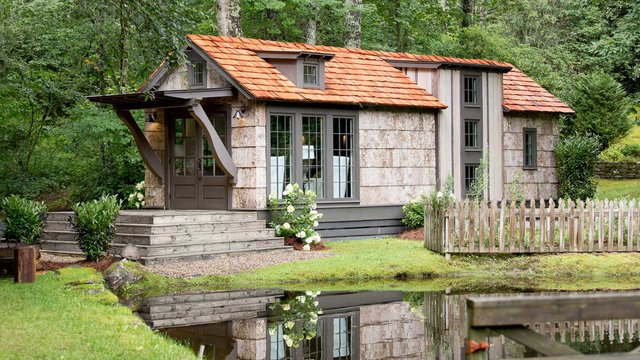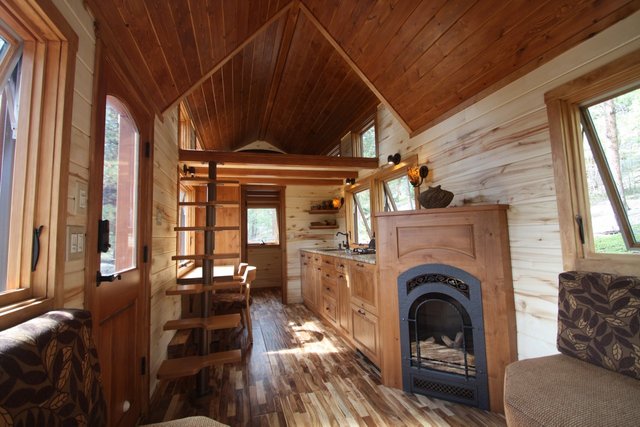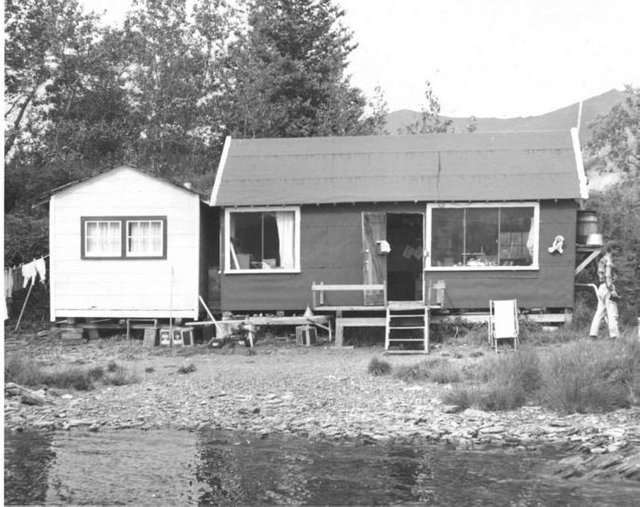
When I first saw the whole tiny house trend, my response was scepticism and caution.
It felt like it was something in the same vein as conditioning people to become used to increasingly smaller living spaces so they’ll more easy assimilate into living in apartments the size of closets yet still paying an arm and a leg for it.
However, the more I looked at it, the more I warmed up to the idea.
And even further, looking back into the history of American home ownership, I realized this is harkening back to a time when young people practiced frugality and living within their means.
What’s a tiny house?

Well, as the name states… it’s a tiny building in which to live.
What we’re typically looking at is a residential structure under 500 square feet, but they usually range between 400 to 1,000 square feet.
There’s a whole ideological impetus behind tiny homes, too:
The tiny house movement promotes financial prudence, eco-friendly choices, shared community experiences, and a shift in consumerism-driven mindsets.
Kilman, Charlie. Small House, Big Impact: The Effect of Tiny Houses on Community and Environment "Small House, Big Impact: The Effect of Tiny Houses on Community and Environment"
It’s difficult for me to say that I disagree with those principals.
One of my favorite things about the tiny house philosophy is design and architecture that maximizes space. Even though another large part of living in a tiny house is a focus on maintaining what is actually important and rejecting frivolity and useless junk, if you only have 500 square feet, you’ve got to find ways to make the most of it.
There’s been a generations-long trend towards bigger houses even though family size is decreasing on average.
In the United States, the average size of new single family homes grew from 1,780 square feet (165 m2) in 1978 to 2,479 square feet (230.3 m2) in 2007, and to 2,662 square feet (247.3 m2) in 2013, despite a decrease in the size of the average family.
What would our homes look like if designed around how we use them?
What tiny homes do is look at what’s actually important -- where do people spend their time, really -- and design a house around that with the intent of being eco-friendly and economically affordable.
And those last two points are why this trend is so popular amongst young people, who are very eco-minded and also do not have the money to pay for increasingly exorbitant home prices.
I mean, seriously, even when I look at the home prices in my local area, which isn’t a major metropolitan economic center with a high average wage, home prices are insanely high, and so is demand, which also increases the cost of rental homes and apartments.
It’s ridiculously expensive just to live in America right now. So the tiny home offers a young person the opportunity to own a house outright, as some of these things can be purchased and built for under $10,000.
And it’s not like your tiny house has to be crappy just because it’s small and much cheaper than a normal house. Just check this thing out.
Back to tradition

It might sound weird to say that something that seems so hip and trendy is actually harkening back to older times, but it’s true.
In the US, generations ago, people didn’t expect to get their first job out of college and have a house similar to their parents.
As mentioned in the previous section, the average home in 1978 was only 1,780 square feet, which is only slightly bigger than an official tiny home on the large end of the spectrum. That was “average”, while houses today are an average of twice that size.
The way it used to work was you got your first good job, bought yourself a house that was probably under 1,000 square feet, and you started to build up your skills, work experience, income, and family, until eventually, down the road, you were able to ACTUALLY AFFORD a house of a bigger size.
Compared to what young people do today, which is to go into massive debt in school and then come out and struggle to even get a job at all -- let alone a “good job” in the field of their education -- and when you DO get a house, it’s simply “normal” to wind up with a 30 year mortgage worth $200,000 on average.
The tiny house movement is the modern expression of that same frugality, with average, modest tiny homes averaging about $25,500, and even luxury tiny homes at around $150,000 (compared to millions for a luxury home of normal size).
How Much Does a Tiny House Really Cost?
This allows a young person to get a home that they can actually afford and pay off (if they even get a loan) in a short period of time so they are not weighed down by debt, working as a slave for the banks for their whole life.
I’m sure, in many cases these people end up preferring a simpler, less cluttered life anyway.
What do you think?

I think tiny homes are kind of cool.
There are even shows about tiny homes:
What do you think about these houses?
In the Netherlands, tiny houses were not just for young people in the past, but for working-class families in general. They were made of brick rather than wood, though. When they're still standing, they're used as single-person housing. We don't live in huge villas/barns like Americans do, but the trend is the same.
My grandfather once came home to find his neighbors sitting at the dinner table. Grandma had decided to move next door, and that took only an afternoon.
When I was a kid, our neighbors liked to remind my parents that they lived in a former chicken shed. It was turned into a house in the 1950s, and the whole family helped to add an extension when I was born in 1971. The yard was covered with random slabs of stone from demolished buildings, we had a big vegetable garden, a flower garden, a chicken shed, a boathouse and a garage turned into a tool shed. We had everything we could wish for. Some of my friends who lived in bigger houses were jealous of me because they had to share their bedroom with a brother and I didn't.
Once I had breakfast in someone's living room that was the size of a ballroom. I felt lost there. It was mostly empty, useless unless you wanted to have a big cocktail party. And I knew that he was rich, but struggling to pay his mortgage after buying at the top of the market just before the 2008 crisis.
Downvoting a post can decrease pending rewards and make it less visible. Common reasons:
Submit
Excellent post, very well explained and with interesting historical data. I believe that it is not necessary that the size of a house be so large. Many times it is exaggerated with space and at the end there are parts of a house that are not used. This contributes to the purchase of more and more things that will not be used over time. The idea must be to economize and know how to adapt. Greetings.
Downvoting a post can decrease pending rewards and make it less visible. Common reasons:
Submit
thank you @shayne for an impressive and well researched post!
I really like the house trend here, they are so practical and innovative in design and what a way to start out for younger folks without going into debt for 200grand.
great job sir!
Downvoting a post can decrease pending rewards and make it less visible. Common reasons:
Submit
I think they are a good option, especially for young people and retirees.
The way I see it, the more options people have the greater ability they have to be self-reliant. Being self-reliant is important for Freedom and Happiness in my opinion.
Downvoting a post can decrease pending rewards and make it less visible. Common reasons:
Submit
Brilliant! Such an informative and well thought out post. Great examples of different tiny homes. A tiny home is almost the best of both worlds. Minimalism with comfort and improved designs to cater for individual requirements
Downvoting a post can decrease pending rewards and make it less visible. Common reasons:
Submit
I think the cheaper ones are a great idea. I also think the expensive ones are ridiculous!
When you factor in house payments, insurance, construction materials and labor, maintenance, etc something like 25-30% of all economic activity goes to housing. Why are we spending so much money on shelter when everything should be getting cheaper as efficiencies and technology improve?
It's the same reason we have vast, sterile lawns that aren't used and drive 80k USD pickup trucks: status.
Downvoting a post can decrease pending rewards and make it less visible. Common reasons:
Submit
Great post, I can't disagree, I love simplicity and efficiency - but I can't help myself. I really can't help myself, must post a South Park link...
BTW - I posted a link that was supposed to start that at 26 seconds in - but apparently that doesn't work here, but it is relevant starting at that point.
I did live in what qualifies as a tiny home for a couple of years. It was a fishing shack built in 1961, it was either a no bedroom or a two bedroom depending on how you looked at it. There was a partition between the living room and bedroom area, but not really a wall, and the old screened in porch was my office. Way more than enough for just me, I actually had a roommate there for a while, he moved in until getting on his feet. Wasn't bad, we worked at the same place, lived at the same place, but since we had different shifts we rarely saw each other much. He slept in the dining area, I just was careful to be quiet when I came and went not to wake him up. He did the same.
I had to move out when Hurricane Ike deposited 4 1/2 feet of ocean in the thing. Been there since 1961 and not until Ike did it take in water according to my neighbor.
Downvoting a post can decrease pending rewards and make it less visible. Common reasons:
Submit
Good article, love the tiny house movement
Downvoting a post can decrease pending rewards and make it less visible. Common reasons:
Submit